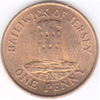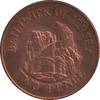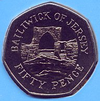- Coins of the Jersey pound
-
The British Crown dependency of Jersey has its own currency, the Jersey pound, which is linked to the pound sterling. As a consequence, the government of Jersey mints its own coins. All coins feature the Queen's head on the obverse, with the following designs on the reverse:
Depiction of Jersey coinage | Reverse side £ 0.01 £ 0.02 £ 0.05 


Le Hocq Tower
(coastal defence)[1]L'Hermitage of
Saint Helier, St Helier[1]Seymour Tower
(offshore defence)[1]£ 0.10 £ 0.20 £ 0.50 


Faldouet Dolmen,
St Martin[1]Lighthouse of
La Corbière[1]Grosnez Castle[1] £ 1.00 £ 2.00 £ 2.00 edge 

Schooner 12 Parish Crests[2] £1 coins have a different design each year. Initially, each new coin featured one of the crests of the 12 parishes of Jersey. These were followed by a series of coins featuring sailing ships built in the island.[2] The motto round the milled edge of Jersey pound coins is: Caesarea Insula ("island of Jersey" in Latin).[2]
History
In 1834, an Order in Council adopted the pound sterling as Jersey's sole official legal tender to replace the Jersey livre, although French copper coins continued to circulate alongside British silver coins, with 26 sous equal to the shilling. Because the sous remained the chief small-change coins, when a new copper coinage was issued for Jersey in 1841, it was based on a penny worth 1⁄13 of a shilling, the equivalent of 2 sous. In 1841, copper 1⁄52, 1⁄26 and 1⁄13 shilling coins were introduced, followed by bronze 1⁄26 and 1⁄13 shilling in 1866.
In 1877 a penny of 1⁄12 of a shilling was introduced, and the system changed to 12 pence to the shilling. Bronze 1⁄48, 1⁄24 and 1⁄12 shilling were introduced. This was the only issue of the 1⁄48 shilling denomination. In 1957, a nickel-brass 3 pence coin was introduced carrying the denomination "one fourth of a shilling". The 1957 and 1960 issues were round, with a dodecagonal version introduced in 1964.
Decimal currency
In 1968, 5 and 10 pence coins were introduced, followed by 50 pence in 1969 and ½, 1 and 2 pence in 1971 when decimalisation took place. All had the same composition and size as the corresponding British coins. The reverse of the first issue of decimal coinage bore the coat of arms of Jersey as had previous coins. The ½ penny coin was last minted in 1981.
A square 1 pound coin was issued in circulation in 1981 to mark the bicentenary of the Battle of Jersey. The square pound could not be accepted by vending machines and was not issued after 1981 although it remains in common circulation today. When the rest of the British Isles started to introduce a standardised pound coin in 1983, Jersey changed to a round coin to match. The square version although rare is still used in the islands. Neither round nor square versions of the coin are as common in Jersey as the 1 pound note.
20 pence coins were introduced in 1982 and 2 pound coins in 1998.
References
- ^ a b c d e f "Coinage of Jersey: Decimal Coinage". jerseycoins.com. http://jerseycoins.com/decimal/dec.htm. Retrieved 2010-07-01.
- ^ a b c "Jersey Pounds". jerseycoins.com. http://jerseycoins.com/com_1/com_1.htm. Retrieved 2010-07-02.
Types of British coinage Falkland Islands · Gibraltar · Guernsey · Isle of Man · Jersey · St Helena and Ascension · United KingdomCategories:- Coins by country
- Economy of Jersey
- Jersey stubs
- Coin stubs
Wikimedia Foundation. 2010.
